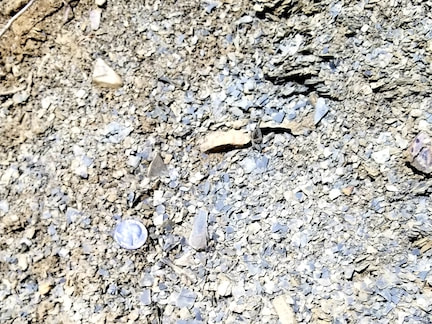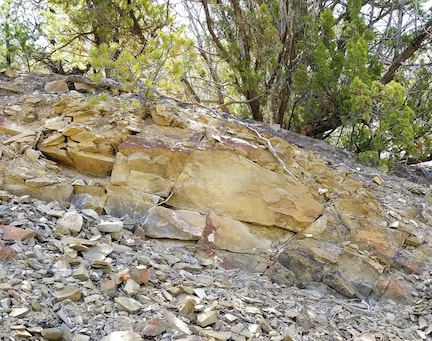The two most abundant chemical elements in the Earth's crust are oxygen and silicon. It follows that nearly all the minerals that make up the common rocks are silicates. Silicate minerals are chemical combinations of oxygen and silicon with a handful of other metallic elements.
With one exception, all of the common silicate minerals break down, during weathering, into tiny particles of clay. Clay is actually a silicate mineral in its own right, a kind of chemical residue of oxygen, silicon, aluminum, and water.
The exceptional silicate is quartz. Quartz is composed of oxygen and silicon atoms only, bound together in a tough 3-D framework that mimics the crystal structure of diamond. As rocks containing quartz disintegrate, the resistant bits of quartz are released, practically untouched, to form sand.
Silt (extremely fine quartz sand) and clay together make up what we commonly call mud. Both of these clastic sediments are easily suspended in moving water and can be carried far offshore in lakes and seas. Deposits of mud settling out of quiet water are widespread.
Now, particles of clay are vanishingly small, and they are shaped like plates or leaves. Imagine tossing a deck of playing cards high into the air. As they settle to the ground, the cards will lay flat, interleaved with one another. If they get damp, they will stick together firmly. Clay-rich clastic sediment that has settled out of quiet water behaves much the same way. It clumps together, but it can be split between the leaves, especially after it compacts into soft rock.
With one exception, all of the common silicate minerals break down, during weathering, into tiny particles of clay. Clay is actually a silicate mineral in its own right, a kind of chemical residue of oxygen, silicon, aluminum, and water.
The exceptional silicate is quartz. Quartz is composed of oxygen and silicon atoms only, bound together in a tough 3-D framework that mimics the crystal structure of diamond. As rocks containing quartz disintegrate, the resistant bits of quartz are released, practically untouched, to form sand.
Silt (extremely fine quartz sand) and clay together make up what we commonly call mud. Both of these clastic sediments are easily suspended in moving water and can be carried far offshore in lakes and seas. Deposits of mud settling out of quiet water are widespread.
Now, particles of clay are vanishingly small, and they are shaped like plates or leaves. Imagine tossing a deck of playing cards high into the air. As they settle to the ground, the cards will lay flat, interleaved with one another. If they get damp, they will stick together firmly. Clay-rich clastic sediment that has settled out of quiet water behaves much the same way. It clumps together, but it can be split between the leaves, especially after it compacts into soft rock.
An old and common name for a mud rock that splits or flakes is shale. Shale is the most abundant of the Earth's sedimentary rocks. Shale is quick to weather right back into mud, forming gently sloping landscapes. In humid climates, shale is soon covered by a mantle of soil and vegetation:
Moving water, in whatever environment it occurs, easily separates sand from silt and clay. Stream channels, tidal flats, beaches, and submarine sand bars are all places where moving water has taken suspended particles of mud downstream or offshore, and left cleanly washed sand behind. Even wind can do this winnowing, sorting sand from finer dust and piling the sand into dunes.
Abandoned and buried accumulations of sand consolidate into sandstone, as the grains of sand are cemented together with films of mineral matter. If the cement is silica from the quartz grains themselves, the resulting rock will be very strong. Other common cements, like calcium carbonate, which is soluble in water, yield a weaker rock. Sandstones cemented with iron oxide minerals are warmly colored in shades of red, orange, and yellow.
Abandoned and buried accumulations of sand consolidate into sandstone, as the grains of sand are cemented together with films of mineral matter. If the cement is silica from the quartz grains themselves, the resulting rock will be very strong. Other common cements, like calcium carbonate, which is soluble in water, yield a weaker rock. Sandstones cemented with iron oxide minerals are warmly colored in shades of red, orange, and yellow.
Shale and sandstone together make up around 80 percent of all sedimentary rocks. Since the minerals of which they are composed are nearly all silicates, geologist distinguish them from other sedimentary rocks by calling them siliciclastic - one of those hybrid words of which they are so fond.




 RSS Feed
RSS Feed
